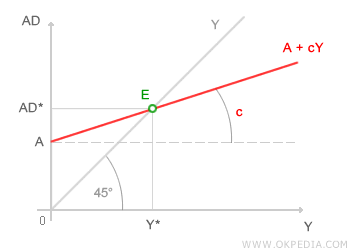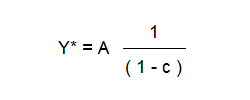Income-Expenditure Model
The income-expenditure model is an economic framework for determining national income. It's widely used in macroeconomics, particularly in Keynesian theory, offering insights into a country's macroeconomic phenomena (economic system). The income-expenditure model reaches equilibrium when aggregate demand (AD) equals national income (Y).
AD = C + I + G + (X - Q)
In this model, the consumption variable (C) is of special significance. Household consumption is based on the following consumption function.
C = C0 + cY
The consumption function determines the level of consumption. In the income-expenditure economic model, consumption is driven by an autonomous component (C0), which is fixed and independent of income, and a variable component dependent on income level (cY). The investment variable (I), on the other hand, is constant since the income-expenditure model is a short-term model where investment choices are considered fixed (constant investments). It's predicated on the assumption that businesses make current investment decisions based on long-term expectations about the future, ignoring short-term economic fluctuations. The investment function can thus be written as follows:
I = I0
The aggregate demand function (AD) can be simplified by considering only two components. The first component groups the constant variables (C0 + I0), those independent of income level, denoted as variable A (autonomous component).
A = (C0 + I0)
The second component includes induced variables, those whose value also depends on income level. Setting aside, for a moment, the public sector (G) and net exports (X - Q), the aggregate demand of a closed economy is as follows:
AD = A + cY
The aggregate demand function can be graphically represented on a Cartesian diagram. The line is identified on the plane by an intercept (A) on the ordinate axis and a slope equal to the marginal propensity to consume (c).

Equilibrium in the income-expenditure model occurs when income (Y) matches aggregate demand (AD). To identify the equilibrium point, it's necessary to also represent the income line. As income is indicated on the abscissa axis of the diagram, it's sufficient to draw a 45-degree rising line from the origin (O) to represent income level on the plane. The equilibrium point (Y=AD) occurs at point E, where the income line (Y) intersects the aggregate demand line (AD). At point E, national income (Y) equals aggregate demand (AD), and the income-expenditure model is in a state of economic equilibrium. The equilibrium income level Y* is referred to as the equilibrium income.
Y* = A + cY
By solving the equation for the equilibrium income variable (Y), it's possible to derive the income multiplier, a crucial tool in macroeconomic analysis. The income multiplier (autonomous demand multiplier) is calculated as the ratio 1 / (1 - c).

 Situations of Disequilibrium. In cases where income is below the equilibrium level (Y < Y*), there is an excess of demand (AD > Y). This prompts businesses to increase production (ΔY). Conversely, when income exceeds the equilibrium level (Y > Y*), there is an excess of supply (Y > AD). Businesses are then compelled to reduce production (ΔY). It's important to note that, as a short-term model, the income-expenditure model assumes constant prices (constant prices).
Situations of Disequilibrium. In cases where income is below the equilibrium level (Y < Y*), there is an excess of demand (AD > Y). This prompts businesses to increase production (ΔY). Conversely, when income exceeds the equilibrium level (Y > Y*), there is an excess of supply (Y > AD). Businesses are then compelled to reduce production (ΔY). It's important to note that, as a short-term model, the income-expenditure model assumes constant prices (constant prices).
 Short Term. The income-expenditure model is a short-term economic model. Prices, wages, and investments are considered constant. In case of economic disequilibrium between aggregate demand (AD) and national income (Y), the adjustment process is focused solely on the quantitative variations of other variables.
Short Term. The income-expenditure model is a short-term economic model. Prices, wages, and investments are considered constant. In case of economic disequilibrium between aggregate demand (AD) and national income (Y), the adjustment process is focused solely on the quantitative variations of other variables.
 Saving Function. In this income-expenditure model, the saving function is not outlined as the variable related to household savings can be obtained by calculating the difference between disposable income (Y) and the consumption function (C).
Saving Function. In this income-expenditure model, the saving function is not outlined as the variable related to household savings can be obtained by calculating the difference between disposable income (Y) and the consumption function (C).
